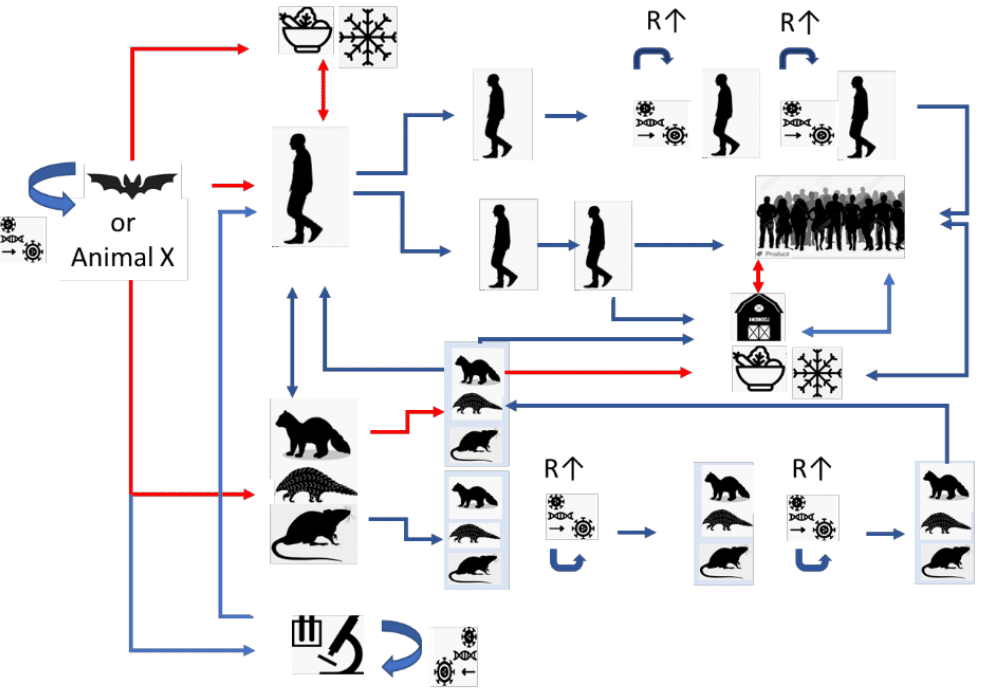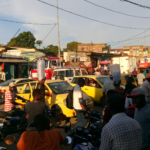WHO’s “exciting adventure” to find the origins of COVID-19 runs into trouble
By Thomas Gaulkin, Matt Field | March 30, 2021
 Schema for the introduction of SARS-CoV-2 through the cold/food chain, from the "WHO-convened Global Study of Origins of SARS-CoV-2: China Part". (WHO)
Schema for the introduction of SARS-CoV-2 through the cold/food chain, from the "WHO-convened Global Study of Origins of SARS-CoV-2: China Part". (WHO)
It’s official. The much anticipated joint-World Health Organization (WHO)-Chinese report on the origins of COVID-19 is in. The 120-page document details findings from epidemiology, molecular biology, DNA sampling, community canvassing, supply chain tracing, and more to trace the first emergence of the virus before the world learned of it in January 2020.
But what isn’t in the report? Any definitive conclusion about where the virus came from.
For that, folks will have to wait, months, years, or—gasp—more than a millennium. (One of the WHO investigators noted Tuesday that it took 1,500 years to understand how measles emerged.) Buckle up, because determining the origins of the 21st century’s worst pandemic—so far—could take a while.
“This is a dynamic process, nothing is cast in stone,” team lead Peter Ben Embarek told reporters Tuesday. “There are no firm conclusions. And I think that’s how we should look at the whole outcome of this report and this work.”
The report, based on the WHO team’s visits to sites in Wuhan, China, along with their work with Chinese counterparts earlier this year, listed four hypotheses about how the virus emerged in humans, ranking them in terms of likelihood. The group, which Ben Embarek said operated on consensus, believes that the most likely pathway is one many experts have long suspected: SARS-CoV-2 leapt from bats to some intermediary animal—similar viruses have been found in pangolins and farmed animals like minks have also been infected—and then into humans. The investigators decided that pathway was “likely to very likely.”
Other possibilities the team analyzed included the virus leaping directly from a bat to a person, being introduced on frozen food, and, most controversially, spreading after a research accident.
At Tuesday’s press conference, the team framed the report as a starting point to guide further investigation. That investigation could take future research beyond the borders of China, in search of bats in China or even South East Asia or food sources elsewhere. “The current thinking is still that we are looking at the start in and around Wuhan, and moving backwards, trying to find out how we came there. And whether it came from another part of China, or elsewhere—that will depend on the further studies and research,” Ben Embarek said.
Some experts argue more study within Wuhan is needed, to rule out the possibility that the initial outbreak was sparked by an accident at one of the laboratories that researched bat coronaviruses in the region. The WHO director-general Tedros Adhanom Ghebreyesus appeared to agree with them. “Although the team has concluded that a laboratory leak is the least likely hypothesis, this requires further investigation,” he said, according to The Washington Post. He said he might send future missions to explore the possibility.
The WHO COVID-19 origins team also appeared to acknowledge that a more thorough investigation would be needed to assess the lab leak scenario. “A true forensic examination of a laboratory, like one might do other types of forensic examinations, is a much more complex process and that’s not what we are there to do,” said Dominic Dwyer, an Australian member of the WHO team.
While the report ranked the possibility of a lab leak as “extremely unlikely,” it ranked another hypothesis that other experts have considered remote as “possible,” and grounds for further investigation: that the outbreak could have started with food or frozen food, potentially at the Huanan Seafood market in Wuhan that has been the focus of so much speculation. Some outbreaks in China have been linked to imported frozen food, but as the report notes, there’s no “conclusive evidence for foodborne transmission of SARS-CoV-2. … While there is some evidence for possible reintroduction of SARS-CoV-2 through handling of imported contaminated frozen products in China since the initial pandemic wave, this would be extraordinary in 2019 where the virus was not widely circulating.”
In other words, it’s possible, but unlikely.
Still, the report suggests following up on any “credible links to products from other countries or regions with evidence for circulation of SARS-CoV-2 before the end of 2019.” But while concrete evidence of a lab leak is similarly lacking, the team took a different approach, offering a comparatively anodyne course of action: “Regular administrative and internal review of high-level biosafety laboratories worldwide. Follow-up of new evidence supplied around possible laboratory leaks.”
That the WHO team is keeping the frozen food theory alive is sure to please some in the Chinese government. Some officials and state media in China have promoted a so-called “multiple-origin” scenario, according to CNN, where the pandemic started with outbreaks in different parts of the world. The report however, is sure to disappoint the scientists, researchers, and officials who suspect a lab leak could have started the pandemic.
And officials in Washington and elsewhere quickly cast doubt on the WHO team’s conclusions. Fourteen countries, including the United States, Japan, and the United Kingdom issued a joint statement saying they were concerned that “the international expert study on the source of the SARS-CoV-2 virus was significantly delayed and lacked access to complete, original data and samples.”
Despite the lack of any conclusive determination about the virus’s origins, the WHO team sounded upbeat about the progress made. “We are still optimistic that we will discover more, we will get closer to the final answer,” Ben Embarek said. “But when and how long it will take, that’s very difficult to predict. So be patient. … It’s an exciting adventure.”
Together, we make the world safer.
The Bulletin elevates expert voices above the noise. But as an independent nonprofit organization, our operations depend on the support of readers like you. Help us continue to deliver quality journalism that holds leaders accountable. Your support of our work at any level is important. In return, we promise our coverage will be understandable, influential, vigilant, solution-oriented, and fair-minded. Together we can make a difference.
Keywords: Coronavirus, World Health Organization, lab leak, pandemic
Topics: Biosecurity

















Here’s a thought on how we might quickly and easily determine the origin of the SARS-CoV-2 virus. In mid-July 2019 a pathogen which the CDC was unable to identify killed a dozen or so at a nursing home in Arlington, VA (The CDC immediately closed down the US Army biolab at Ft. Detrick). I should think the CDC has blood samples from the victims. Let’s analyze it. If the coronavirus is found in the samples, bingo!, we know where the virus originated: Ft. Detrick.
An accidental leak is viewed as unlikely because it unacceptable to the medical science community. If an air-borne virus is released in a very large city that is infectious long before people get sick, it will create a global pandemic before the locals know they have a problem. It is the combination of high population densities, mass transit and a global air transport industry. that makes stopping such diseases impossible by conventional methods. If the virus leaked out of a Chinese lab, every bio-level 4 laboratory in the U.S. and Europe will be shut down and forced to move to… Read more »
Nicholas Wade’s article earlier in May nailed it for me. Originally, I was with those who declared C19 a natural spill over and that a lab-based origin, particularly in Wuhan was just conspiratorial spinning. On reading round the subject, however, I became less convinced and Wade’s excellent summary crystallised my misgivings into a complete turn around for me. As far as Occam’s razor is concerned (the simplest explanation is most likely to be the correct one) a lab-based origin and accidental release seems obvious. Note the emphasis on accidental not some James Bondesque attempt at world domination by Blofeld. Human… Read more »
It is useful to look back in history to the Cold War era and the outbreak of Anthrax in the USSR near Sverdlovsk. The USSR and several major American universities “determined conclusively” that the Anthrax came from natural sources and that those who advanced the biowarfare theory were simply Right Wing Warmongers. Only later, after the defection of one of the Soviet’s top biowarfare leaders was the real story released. The area was the site of a Soviet facility mass producing Anthrax. An operational error resulted in an exhaust fan being run with the filters removed for maintenance.